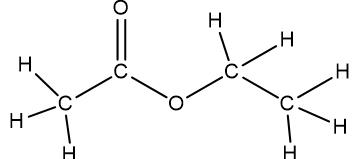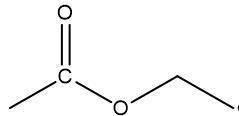
Introduction to Chemistry
4th Edition
ISBN: 9780073523002
Author: Rich Bauer, James Birk Professor Dr., Pamela S. Marks
Publisher: McGraw-Hill Education
expand_more
expand_more
format_list_bulleted
Concept explainers
Question
Chapter 16, Problem 14QP
(a)
Interpretation Introduction
Interpretation:
The structural formula and the line structure of the given ball and stick model is to be drawn.
(b)
Interpretation Introduction
Interpretation:
The structural formula and the line structure of the given ball and stick model is to be drawn.
(c)
Interpretation Introduction
Interpretation:
The structural formula and the line structure of the given ball and stick model is to be drawn.
Explanation:
Consider the given ball and stick model. The black balls represent carbon atoms and the grey balls represent hydrogen atoms. Thus, the structural formula is,

The line structure for the above molecule is,

Expert Solution & Answer
Want to see the full answer?
Check out a sample textbook solution
Students have asked these similar questions
Identifying the stereochemistry of natural
Write the complete common (not IUPAC) name of each molecule below.
Note: if a molecule is one of a pair of enantiomers, be sure you start its name with D- or L- so we know which enantiomer it is.
molecule
H
O-C-CH2
H3N.
HN
N
H
C=O
common name
(not the IUPAC
name)
NH3
☐
H3N
H
☐
CH2
X
>
Draw the structure of alanine at pH 1.2.
Click and drag to start drawing a
structure.
Understanding the general acid-base properties of amino acids
O Proteins
Imagine each of the molecules shown below was found in an aqueous solution. Can you tell whether the solution is acidic, basic, or
neutral?
molecule
The solution is...
010
H3N-CH-C-OH
CH
HO
CH3
O acidic
O basic
neutral
O (unknown)
H3N
HO
0
O acidic
O basic
neutral
○ (unknown)
H3N-CH-C-O
CH2
CH3-CH-CH3
O acidic
O basic
Oneutral
○ (unknown)
O=
X
H2N-CH-C-O
CH3
CH
CH3
acidic
O basic
O neutral
○ (unknown)
?
000
Chapter 16 Solutions
Introduction to Chemistry
Ch. 16 - Prob. 1QCCh. 16 - Prob. 2QCCh. 16 - Prob. 3QCCh. 16 - What are cyclic hydrocarbons, and how do they...Ch. 16 - Prob. 5QCCh. 16 - Prob. 6QCCh. 16 - Prob. 7QCCh. 16 - Prob. 8QCCh. 16 - Prob. 9QCCh. 16 - Prob. 1PP
Ch. 16 - Prob. 2PPCh. 16 - Prob. 3PPCh. 16 - Prob. 4PPCh. 16 - Prob. 5PPCh. 16 - Prob. 6PPCh. 16 - Prob. 7PPCh. 16 - Prob. 8PPCh. 16 - Prob. 9PPCh. 16 - Prob. 10PPCh. 16 - Prob. 11PPCh. 16 - Prob. 1QPCh. 16 - Prob. 2QPCh. 16 - Prob. 3QPCh. 16 - Prob. 4QPCh. 16 - Prob. 5QPCh. 16 - Prob. 6QPCh. 16 - Prob. 7QPCh. 16 - Prob. 8QPCh. 16 - Prob. 9QPCh. 16 - Prob. 10QPCh. 16 - Prob. 11QPCh. 16 - Prob. 12QPCh. 16 - Prob. 13QPCh. 16 - Prob. 14QPCh. 16 - Prob. 15QPCh. 16 - Prob. 16QPCh. 16 - Prob. 17QPCh. 16 - Prob. 18QPCh. 16 - Prob. 19QPCh. 16 - Prob. 20QPCh. 16 - Prob. 21QPCh. 16 - Prob. 22QPCh. 16 - Prob. 23QPCh. 16 - Prob. 24QPCh. 16 - Prob. 25QPCh. 16 - Prob. 26QPCh. 16 - Prob. 27QPCh. 16 - Prob. 28QPCh. 16 - Prob. 29QPCh. 16 - Prob. 30QPCh. 16 - Prob. 31QPCh. 16 - Prob. 32QPCh. 16 - Prob. 33QPCh. 16 - Prob. 34QPCh. 16 - Prob. 35QPCh. 16 - Prob. 36QPCh. 16 - Prob. 37QPCh. 16 - Prob. 38QPCh. 16 - Prob. 39QPCh. 16 - Prob. 40QPCh. 16 - Prob. 41QPCh. 16 - Write IUPAC names for the following compounds....Ch. 16 - Prob. 43QPCh. 16 - Prob. 44QPCh. 16 - Prob. 45QPCh. 16 - Prob. 46QPCh. 16 - Prob. 47QPCh. 16 - Prob. 48QPCh. 16 - Prob. 49QPCh. 16 - Prob. 50QPCh. 16 - Prob. 51QPCh. 16 - Prob. 52QPCh. 16 - Prob. 53QPCh. 16 - Prob. 54QPCh. 16 - Prob. 55QPCh. 16 - Prob. 56QPCh. 16 - Prob. 57QPCh. 16 - Prob. 58QPCh. 16 - Prob. 59QPCh. 16 - Prob. 60QPCh. 16 - Prob. 61QPCh. 16 - Prob. 62QPCh. 16 - Prob. 63QPCh. 16 - Prob. 64QPCh. 16 - Prob. 65QPCh. 16 - Prob. 66QPCh. 16 - Prob. 67QPCh. 16 - Prob. 68QPCh. 16 - Prob. 69QPCh. 16 - Prob. 70QPCh. 16 - Prob. 71QPCh. 16 - Prob. 72QPCh. 16 - Prob. 73QPCh. 16 - Prob. 74QPCh. 16 - Prob. 75QPCh. 16 - Prob. 76QPCh. 16 - Prob. 77QPCh. 16 - Prob. 78QPCh. 16 - Prob. 79QPCh. 16 - Prob. 80QPCh. 16 - Prob. 81QPCh. 16 - Prob. 82QPCh. 16 - Prob. 83QPCh. 16 - Prob. 84QPCh. 16 - Prob. 85QPCh. 16 - Prob. 86QPCh. 16 - Prob. 87QPCh. 16 - Prob. 88QPCh. 16 - Predict and explain the relative boiling points of...Ch. 16 - Prob. 90QPCh. 16 - Prob. 91QPCh. 16 - Prob. 92QPCh. 16 - Prob. 93QPCh. 16 - Prob. 94QPCh. 16 - Prob. 95QPCh. 16 - Prob. 96QPCh. 16 - Prob. 97QPCh. 16 - Prob. 98QPCh. 16 - Prob. 99QPCh. 16 - Prob. 100QPCh. 16 - Prob. 101QPCh. 16 - Prob. 102QPCh. 16 - Prob. 103QPCh. 16 - Prob. 104QPCh. 16 - Prob. 105QPCh. 16 - Prob. 106QPCh. 16 - Prob. 107QPCh. 16 - Prob. 108QPCh. 16 - Prob. 109QPCh. 16 - Prob. 110QPCh. 16 - Prob. 111QPCh. 16 - Prob. 112QPCh. 16 - Prob. 113QPCh. 16 - Prob. 114QPCh. 16 - Prob. 115QPCh. 16 - Prob. 116QPCh. 16 - Prob. 117QPCh. 16 - Prob. 118QPCh. 16 - Prob. 119QPCh. 16 - Prob. 120QPCh. 16 - Prob. 121QPCh. 16 - Draw the line structures for the ether and two...Ch. 16 - Prob. 123QPCh. 16 - Prob. 124QPCh. 16 - Prob. 125QPCh. 16 - Prob. 126QPCh. 16 - Write structural formulas for all the isomers of...Ch. 16 - Prob. 128QPCh. 16 - Prob. 129QPCh. 16 - Prob. 130QPCh. 16 - Prob. 131QPCh. 16 - Prob. 132QPCh. 16 - Prob. 133QPCh. 16 - Prob. 134QPCh. 16 - Prob. 135QPCh. 16 - Prob. 136QPCh. 16 - Prob. 137QPCh. 16 - Prob. 138QPCh. 16 - Prob. 139QPCh. 16 - Prob. 140QPCh. 16 - Prob. 141QPCh. 16 - Prob. 142QPCh. 16 - Prob. 143QP
Knowledge Booster
Learn more about
Need a deep-dive on the concept behind this application? Look no further. Learn more about this topic, chemistry and related others by exploring similar questions and additional content below.Similar questions
- Imagine each of the molecules shown below was found in an aqueous solution. Can you tell whether the solution is acidic, basic, or neutral? molecule 0=0 H3N-CH-C-o HO CH2 OH The solution is... O acidic O basic O neutral O (unknown) H₂N acidic O basic O neutral ○ (unknown) + H3N O OH O acidic O basic O neutral O (unknown) H2N-CH-C-O CH3 O acidic O basic neutral ○ (unknown) X ? olo HEarrow_forwardRecognizing ampli Draw an a amino acid with a methyl (-CH3) side chain. Explanation Check Click and drag to start drawing a structure. X Carrow_forwardWrite the systematic name of each organic molecule: structure name × HO OH ☐ OH CI CI O CI OH OHarrow_forward
- く Check the box under each a amino acid. If there are no a amino acids at all, check the "none of them" box under the table. Note for advanced students: don't assume every amino acid shown must be found in nature. COO H3N-C-H CH2 HO CH3 NH3 O CH3-CH CH2 OH Onone of them Explanation Check + H3N O 0. O OH + NH3 CH2 CH3-CH H2N C-COOH H O HIC + C=O H3N-C-O CH3- - CH CH2 OH Х 2025 McGraw Hill LLC. All Rights Reserved. Terms of Use | Privacy Center Accesarrow_forwardWrite the systematic name of each organic molecule: structure HO-C-CH2-CH3 O -OH CH3-CH2-CH2-CH2-CH2-C-OH CH3 CH3-CH-CH2-C-OH Explanation Check S namearrow_forwardtheres 2 productsarrow_forward
- Draw the major product of this solvolysis reaction. Ignore any inorganic byproducts. + CH3CH2OH Drawing Q Atoms, Bonds and Rings OCH2CH3 || OEt Charges OH 00-> | Undo Reset | Br Remove Done Drag To Pan +arrow_forwardDraw the major product of this SN1 reaction. Ignore any inorganic byproducts. CH3CO2Na CH3CO2H Drawing + Br Q Atoms, Bonds and Rings OAC Charges OH ОАс Na ဂ Br Undo Reset Remove Done Drag To Pan +arrow_forwardOrganic Functional Groups entifying positions labeled with Greek letters in acids and derivatives 1/5 ssible, replace an H atom on the a carbon of the molecule in the drawing area with a ce an H atom on the ẞ carbon with a hydroxyl group substituent. ne of the substituents can't be added for any reason, just don't add it. If neither substi er the drawing area. O H OH Oneither substituent can be added. Check D 1 Accessibility ado na witharrow_forward
- Differentiate between electrophilic and nucleophilic groups. Give examples.arrow_forwardAn aldehyde/ketone plus an alcohol gives a hemiacetal, and an excess of alcohol gives an acetal. The reaction is an equilibrium; in aldehydes, it's shifted to the right and in ketones, to the left. Explain.arrow_forwardDraw a Haworth projection or a common cyclic form of this monosaccharide: H- -OH H- OH H- -OH CH₂OHarrow_forward
arrow_back_ios
SEE MORE QUESTIONS
arrow_forward_ios
Recommended textbooks for you
 Introductory Chemistry: An Active Learning Approa...ChemistryISBN:9781305079250Author:Mark S. Cracolice, Ed PetersPublisher:Cengage Learning
Introductory Chemistry: An Active Learning Approa...ChemistryISBN:9781305079250Author:Mark S. Cracolice, Ed PetersPublisher:Cengage Learning Chemistry: Matter and ChangeChemistryISBN:9780078746376Author:Dinah Zike, Laurel Dingrando, Nicholas Hainen, Cheryl WistromPublisher:Glencoe/McGraw-Hill School Pub Co
Chemistry: Matter and ChangeChemistryISBN:9780078746376Author:Dinah Zike, Laurel Dingrando, Nicholas Hainen, Cheryl WistromPublisher:Glencoe/McGraw-Hill School Pub Co Living By Chemistry: First Edition TextbookChemistryISBN:9781559539418Author:Angelica StacyPublisher:MAC HIGHER
Living By Chemistry: First Edition TextbookChemistryISBN:9781559539418Author:Angelica StacyPublisher:MAC HIGHER World of Chemistry, 3rd editionChemistryISBN:9781133109655Author:Steven S. Zumdahl, Susan L. Zumdahl, Donald J. DeCostePublisher:Brooks / Cole / Cengage Learning
World of Chemistry, 3rd editionChemistryISBN:9781133109655Author:Steven S. Zumdahl, Susan L. Zumdahl, Donald J. DeCostePublisher:Brooks / Cole / Cengage Learning

Introductory Chemistry: An Active Learning Approa...
Chemistry
ISBN:9781305079250
Author:Mark S. Cracolice, Ed Peters
Publisher:Cengage Learning


Chemistry: Matter and Change
Chemistry
ISBN:9780078746376
Author:Dinah Zike, Laurel Dingrando, Nicholas Hainen, Cheryl Wistrom
Publisher:Glencoe/McGraw-Hill School Pub Co

Living By Chemistry: First Edition Textbook
Chemistry
ISBN:9781559539418
Author:Angelica Stacy
Publisher:MAC HIGHER


World of Chemistry, 3rd edition
Chemistry
ISBN:9781133109655
Author:Steven S. Zumdahl, Susan L. Zumdahl, Donald J. DeCoste
Publisher:Brooks / Cole / Cengage Learning